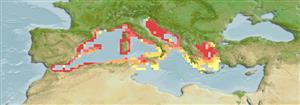Teleostei (teleosts) >
Gobiiformes (Gobies) >
Gobiidae (Gobies) > Gobiinae
Etymology: Gobius: Latin, gobius = gudgeon (Ref. 45335); kolombatovici: Named for Juraj Kolombatovic (1843-1908), a Croatian taxonomist.
Eponymy: Juraj Kolombatovic (1843–1908) was a Croatian Professor of mathematics, a natural scientist, taxonomist and ichthyologist. [...] (Ref. 128868), visit book page.
Environment: milieu / climate zone / depth range / distribution range
Ecology
Marine; demersal; depth range 15 - 90 m (Ref. 92840). Temperate
Mediterranean Sea: northern Adriatic Sea.
Size / Weight / Age
Maturity: Lm ? range ? - ? cm
Max length : 9.2 cm SL male/unsexed; (Ref. 37044); 9.1 cm SL (female)
Dorsal spines (total): 7; Dorsal soft rays (total): 13 - 14; Anal spines: 1; Anal soft rays: 13; Vertebrae: 28. Distinguishable from the other north-eastern Atlantic and Mediterranean Gobius species by: (1) row g reaching lateral end of row o, (2) row o variably related to fellow in dorsal midline, usually connected or overlapping, but sometimes separate (in fig.4), (3) body and head with orange spots and blotches, body spots and blotches clearly visible even in preserved specimens, after loss of orange coloration, and (4) first dorsal fin with black blotch in upper posterior corner, remaining also in preserved specimens. It further differs from G. cruentatus in (1) absence of cheek scales, and (2) shorter row x, not reaching pore ß anteriorly. G. kolombatovici also differs by a higher number of scales in lateral series (Ref. 37044).
Gobius kolombatovici is a bottom-dwelling and secretive species, observed at depths of 15-38 m. It was found to inhabit localities with a combination of soft sediment and rock. Common fish in the same habitat are epibenthic Gobius vittatus, Parablennius rouxi, Thorogobius macrolepis and hyper-benthic Coris julis, Chromis chromis and Serranus hepatus (Ref. 37044).
Life cycle and mating behavior
Maturity | Reproduction | Spawning | Eggs | Fecundity | Larvae
Kovačić, M. and P.J. Miller, 2000. A new species of Gobius (Teleostei: Gobiidae) from the northern Adriatic Sea. Cybium 24(3):231-239. (Ref. 37044)
IUCN Red List Status (Ref. 130435: Version 2024-2)
Threat to humans
Harmless
Human uses
Tools
Special reports
Download XML
Internet sources
Estimates based on models
Preferred temperature (Ref.
123201): 13.3 - 17, mean 14.7 °C (based on 26 cells).
Phylogenetic diversity index (Ref.
82804): PD
50 = 0.5000 [Uniqueness, from 0.5 = low to 2.0 = high].
Bayesian length-weight: a=0.01023 (0.00477 - 0.02194), b=3.01 (2.83 - 3.19), in cm total length, based on LWR estimates for this (Sub)family-body shape (Ref.
93245).
Trophic level (Ref.
69278): 3.2 ±0.2 se; based on size and trophs of closest relatives
Resilience (Ref.
120179): High, minimum population doubling time less than 15 months (Preliminary K or Fecundity.).
Fishing Vulnerability (Ref.
59153): Low vulnerability (10 of 100).
